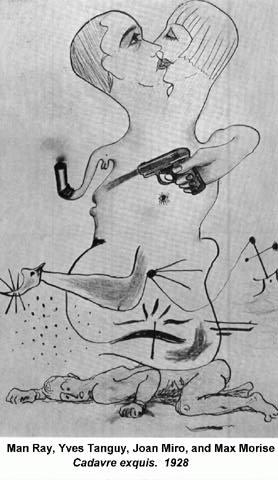On October 13, 2005, V2 and Piet Zwart Institute organized
Design Documents: Mapping communication in interdisciplinary and anti-disciplinary work with media, software and society.
Key issue during this seminar was how interdisciplinary teams communicate with eachother, the user and the commissioner. What does a design document look like?
Matthew Fuller, organizer of the event, opened the seminar with a series of definitions. Media design should be more than sprinkling some pixels on a database to make it look nice. Design is where thoughts meet composition and production. As a classic preamble of a design document, Fuller showed the audience an example of a ‘cadavre exquis’ (exquisite corpse). This technique was used by the surrealists to make a collective writing or drawing. Players write or draw on a piece of papers, and fold the paper to conceal their part of the drawing. They mark the points where to continue and pass it on to the next player for a further contribution. What are these marking points in contemporary design practice? www.pzwart.wdka.hro.nl

Nina Wakeford (INCITE lab, Surrey) is well-known for her combination of design and research practice and queer theory. At the INCITE lab, Wakeford has worked on numerous commercial and non-commercial assignments in multidisciplinary teams. Wakeford started her talk by invited the audience to put their keys in a bowl. Referring to both the swinger parties of the 60s, and the idea of an intimate collaboration in teams, as well as the idea of the ‘boundary object’, Wakeford stressed that we shouldn’t think of collaboration as a heroic act. To be a designer means to collaborate, it’s part of the deal. Queer theory can function as a tool to discuss social collaborations.
http://incite.surrey.ac.uk
Kristina Andersen illustrated her projects that largely deal with sensors and sensuality. She strongly advocates involving the audience in the work in an early stage. Her project Faraway/if only focused on the way people communicate that are emotionally close but physically distant. ‘Whisper[s]’ is a collaborative project involving artists (dance, sculpture, music), designers (of visuals, objects & textiles), computer scientists and hardware/software engineers, developing poetic wearable technology.
www.lockergirl.com
McKenzie Wark is Professor of Cultural and Media Studies at Lang College, New School University. He is the author of several books, most recently Dispositions and A Hacker Manifesto. McKenzie Wark elaborated on his ideas formulated in his Hacker Manifesto, in which he regards hackers, as well as vectoralists, as a class. In his talk, he also commented on things said at the seminar. He replied to Nina Wakeford’s statement on not considering collaboration as a heroic act, with: “Collaboration is more than heroic, it’s utopian”. His class division surely caused a discussion , as did his broader definition of the hacker.
McKenzie Wark (2004), A Hacker Manifesto, Cambridge: Harvard University Press.
www.ludiccrew.org
Jeanne van Heeswijk & Dennis Kaspori ended the seminar with a down to earth presentation on what they call ‘inclusive urbanism’, or ‘open source architecture’ . Their Face your World project, in which school kids and inhabitants worked on the design of a new park in the centre of the neighborhood Amsterdam Slotervaart.
Face your world: towards bottom-up urban renewal and inclusive urbanism
Jeanne stressede the importance of reconnecting people to the environment they’re living in. Make sure they feel part of the creation of their public space. To achieve this, Van Heeswijk and Kaspori created the ‘interactor’, a set of tools that allows people to quickly access design processes. In the end, the architects worked with a team 55 (!) people, which included city planners, local experts, theorists, programmers, and locals as co-curators of the park.
www.jeanneworks.net
www.faceyourworld.net
www.themaze.org
Design Documents was organized by the Piet Zwart Institute, MA Media Design Research. A transcription of all presentations will soon be available online at www.pzwart.wdka.hro.nl.

